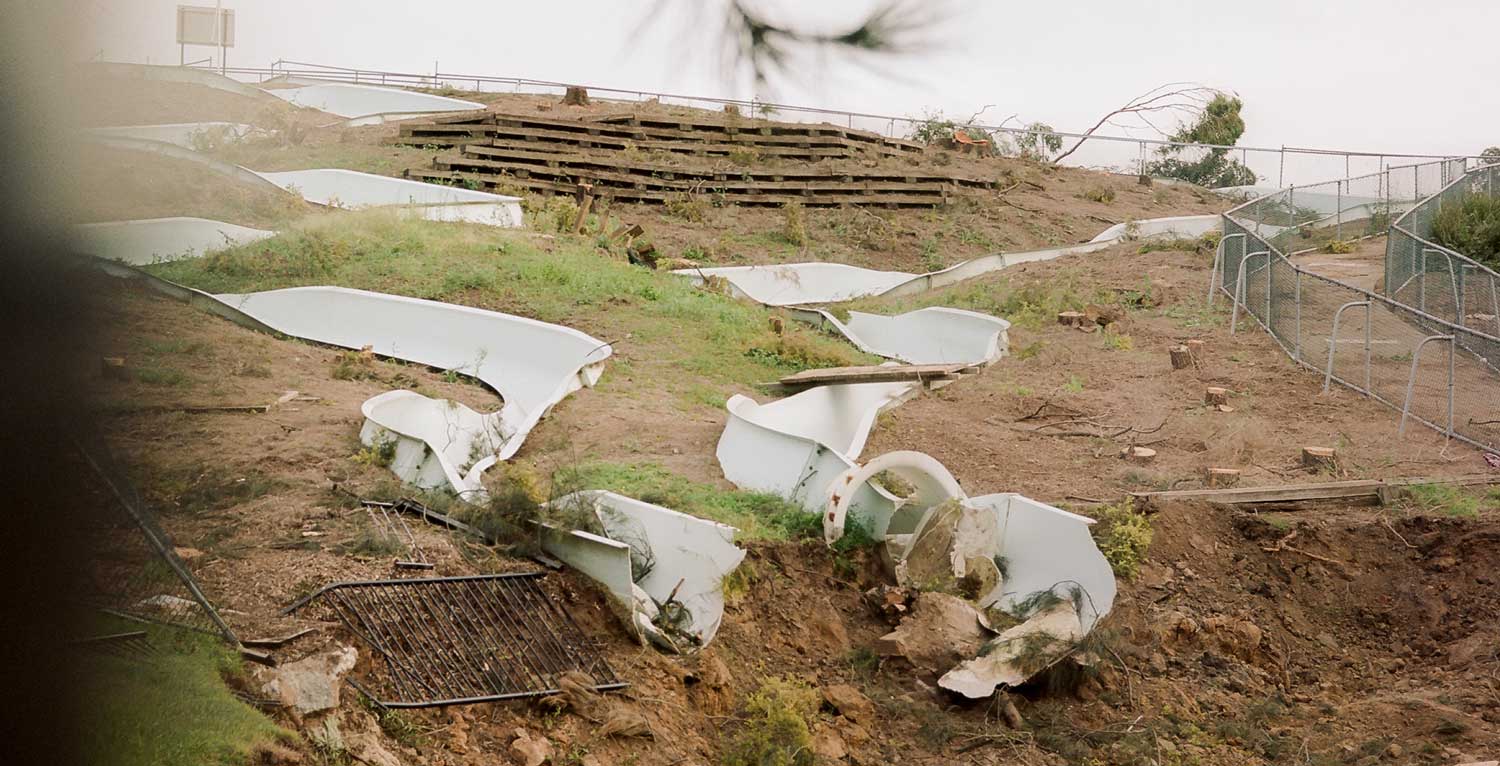
Making what happen? The fate of Parramatta Park
Former NSW Premier Mike Baird is responsible for many things: lockouts, WestConnex, and the catchphrase, “NSW – Making it happen”. Hoardings around central Parramatta are adorned with this phrase. But, as Paulette Wallace wonders, what exactly will “happen” to the city’s green heart?
Parramatta is being transformed into “Australia’s next great city”―a hub for all things business, culture and sport. At least, that’s how UrbanGrowth NSW, the New South Wales government’s urban transformation agency, would have it. To achieve this, the government is supporting a raft of development initiatives that incorporate not just the much-needed construction of new infrastructure, but also the redevelopment, sale or destruction of some much-loved community assets. This includes, but is certainly not limited to: the demolition of the Pirtek Stadium to create a new Western Sydney Stadium; the demolition of the existing Parramatta War Memorial Pool to create a pedestrian corridor for the new stadium; the redevelopment of Parramatta RSL; the $2 billion Parramatta Square project; the redevelopment of Old Kings School; the construction of 2700 apartments in the historic Cumberland Hospital and Parramatta Female Factory precinct; plus the extensive CBD high-rise developments like Meriton’s 54-storey Altitude. Much of this transformation affects or even chews directly into Parramatta Park – the green heart of the city. Some might say this is “NSW – Making it happen”, but is all this “happening” in the best interest of New South Wales and, more specifically, Parramatta?
Some of those concerned about the Parramatta boom see it as driven by political prerogatives, where short-term thinking is masked as long-term vision. They also point to the fact that these dramatic changes are occurring at a time when the City of Parramatta Council has a government-appointed city administrator, implying state meddling in local community matters. Parramatta, it seems, is at risk of an enforced vibrancy, which gives the people what the government says they need, rather than what a democratically-elected council might implement in response to the demands of its constituents. The sad reality is that many of these developments are subsuming Parramatta’s distinct identity, transforming it into a city that could be found anywhere in the world.
Much of the modern city of Parramatta sits on or near the Parramatta Sand Sheet, an ancient geomorphological feature that holds evidence of the lives lived in this area at least 6000 years ago. Archaeologists from GML Heritage along with representatives from the Darug Aboriginal Landcare organisation even go as far as to suggest that Parramatta was probably first occupied during the Late Pleistocene period, or around 30,000 years ago. Derived from the Darug word Burramatta, “the place where the eels lie down”, the city rests on the banks of the Parramatta River and was the second area settled by Europeans after initial agricultural experiments at Sydney Cove. The natural resources that drew the Europeans – water (for crops and as a means of transportation) and the fertile floodplain around it – were also valued by the Darug people of this area, who fished in the river and hunted in its surrounding forests and grasslands. In this rich food bowl, both the Darug people and European settlers gathered and made their homes, peacefully and through force.
The current day Parramatta Park, with its green open space and Parramatta River carved through its core, is a lifeline to the generations of experiences that have gone before. The 85-hectare park was the site of a residence and office for 12 prominent colonial governors from Governor Phillip in 1788 until Governor Denison in 1856, with the existing Old Government House being a result of the second major rebuild in 1817. Old Government House with its surrounding domain operated as an important administrative hub for the colonies of New South Wales and Van Diemen’s Land. It was from here, also, where Australia’s convict system was implemented and controlled. The significance of the colonial legacy of Old Government House and Domain was recognised on the world stage in 2010, when the site was included within the 11 site collective that makes up the Australian Convict Sites World Heritage Property.
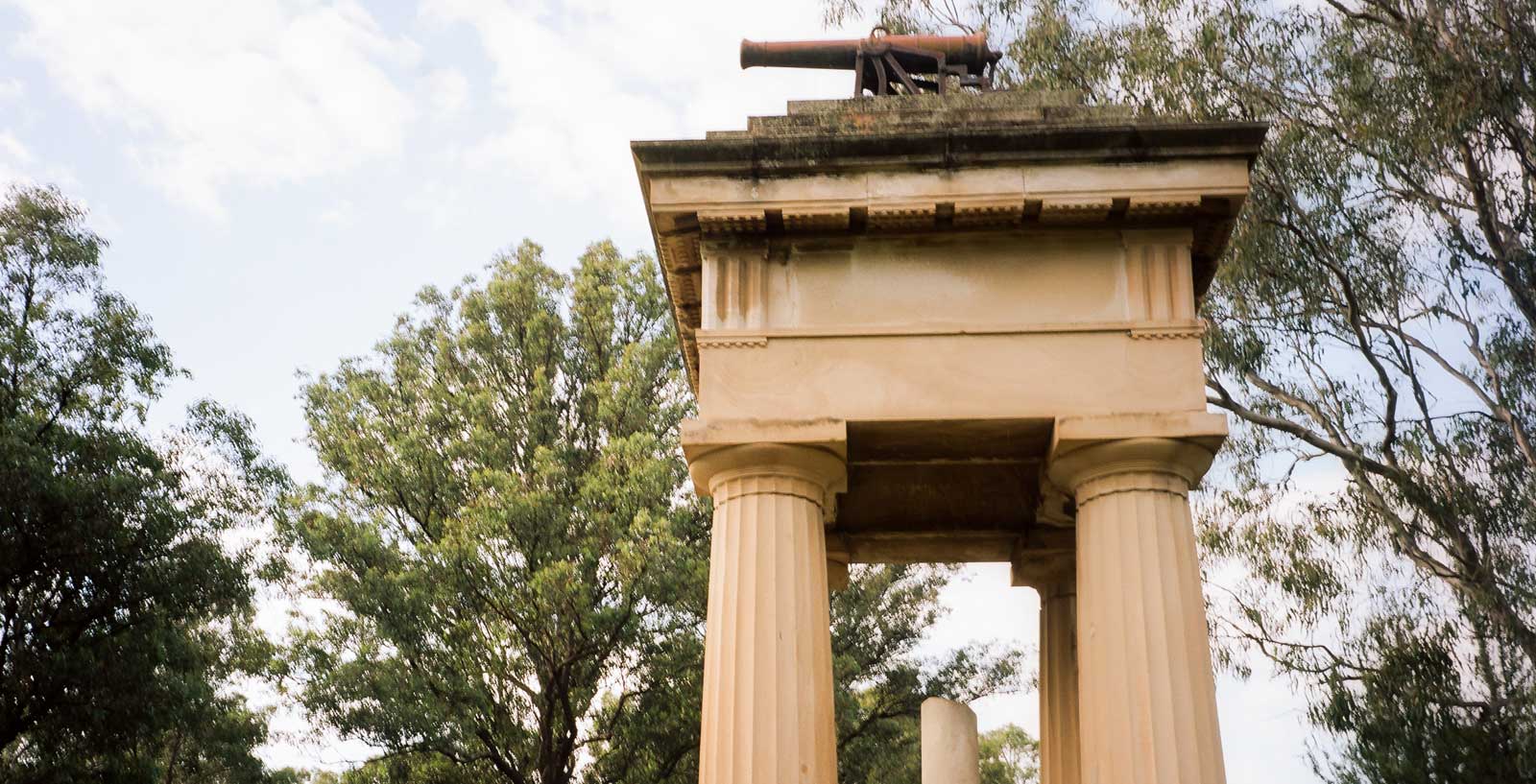
Boer War Memorial. Image: Chris Loutfy.
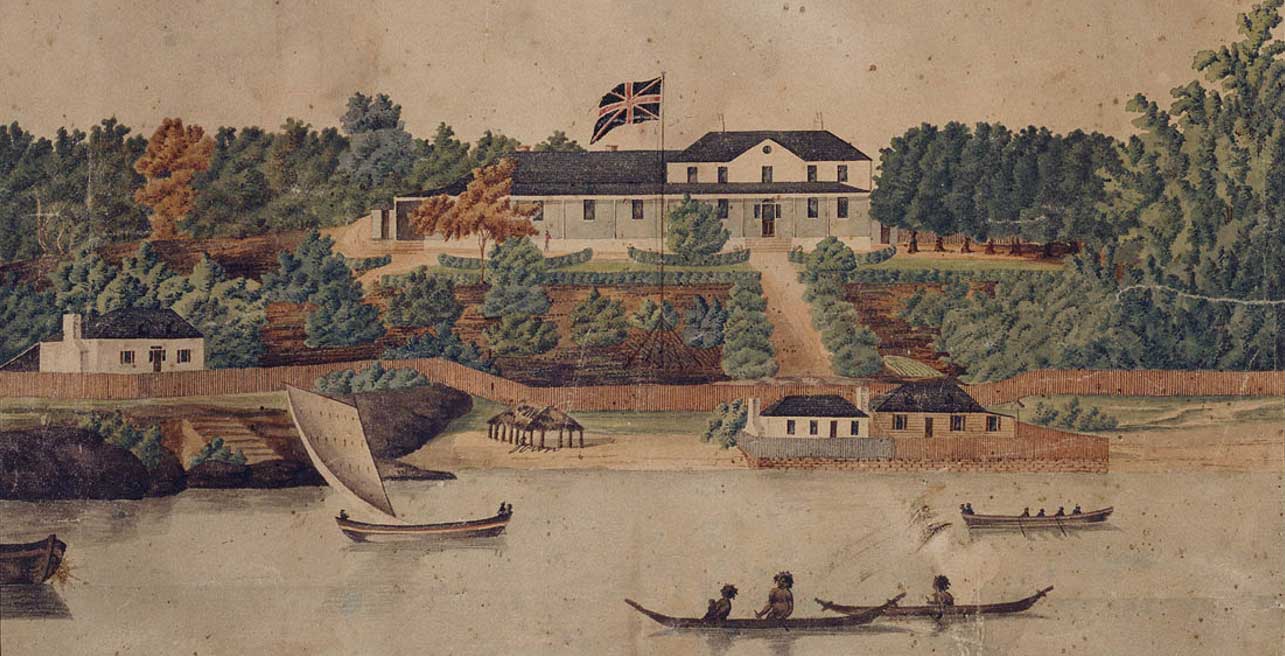
First Government House, Sydney. Watercolour drawing by John Eyre ca. 1807. Courtesy of the State Library of NSW.
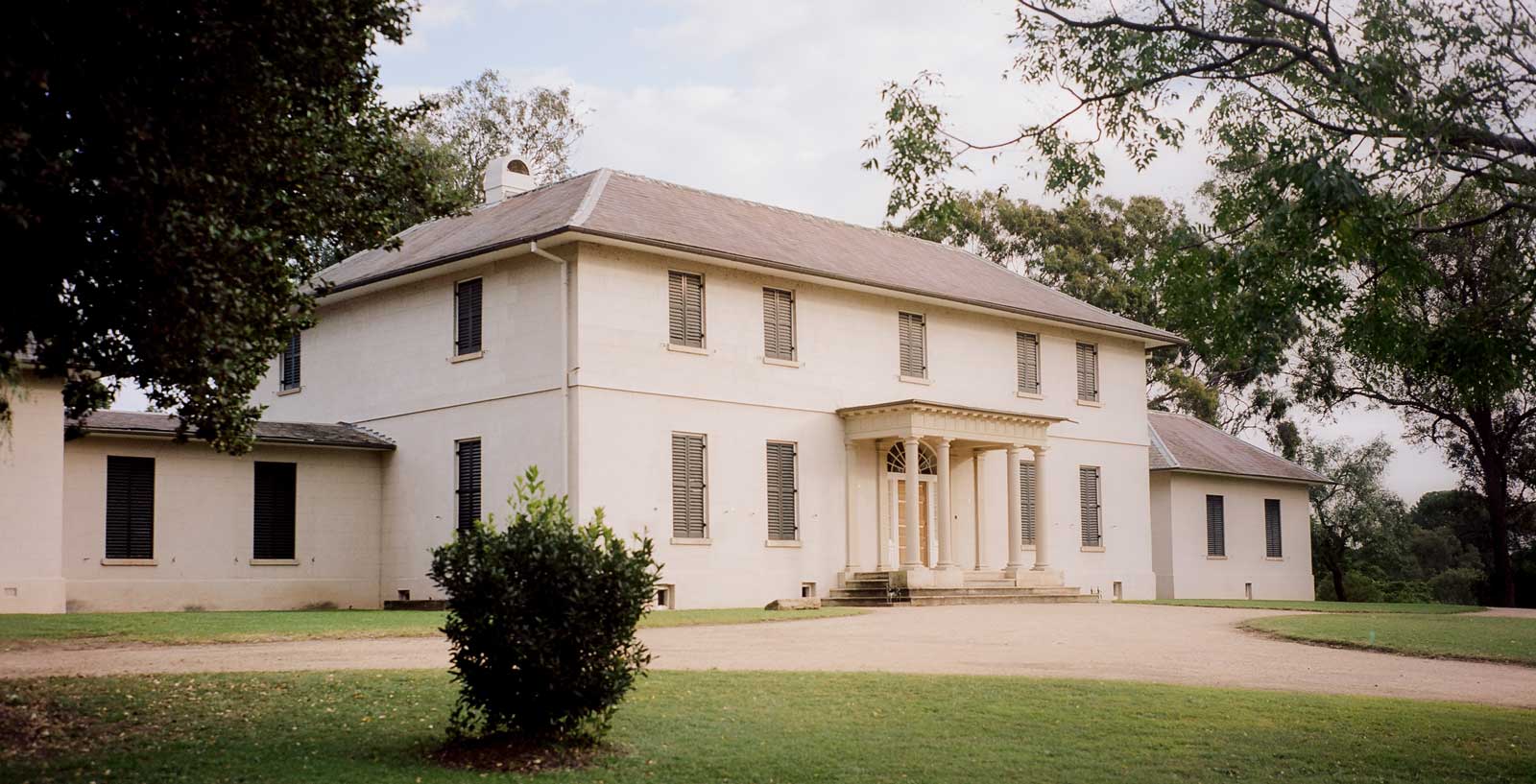
Old Government House in 2017. Image: Chris Loutfy.
Across all of these layers of heritage, successive inhabitants have built up and reinforced connections to the Parramatta landscape. The evidence of these different land uses were recognised because of the efforts of the Parramatta Citizens’ Movement for Recreation in Open Lands, who lobbied for the government domain to be preserved and opened to the public once the Governors had moved out. The Parramatta Domain Act 1857 required that a minimum of 200 acres (81 hectares) “shall be reserved from sale and shall be set apart for and granted as a Park for promoting the health and recreation of the inhabitants of the Town of Parramatta.” At the 150th anniversary of Parramatta Park in 2008, 4000 people gathered together in a human chain around the 1858 boundary and formed a huge “150” to mark the occasion. Since then, the spirit of the origin of Parramatta Park continues to endure with local communities rallying when the park and surrounds are threatened. The North Parramatta Residents’ Action Group was formed in January 2015 in response to the public exhibition of proposals by UrbanGrowth NSW in the Parramatta North Urban Renewal Project. The recent “Save Salter Field Playground” and the “Save Parramatta Pool” are further community campaigns, with the latter involving a “Togs on Fence” protest to show the state government how important the Parramatta War Memorial Pool is to the people of Western Sydney. Yet despite these efforts, the communities’ concerns do not appear to have influenced the development currently occurring in Parramatta Park.
The changes proposed both within and on the doorstep of Parramatta Park need to be based on informed decision-making that takes the core values of the park into account. These include its history, but shouldn’t be limited to history alone. The City of Parramatta Council needs to build a living knowledge base – it needs to know what people love about Parramatta Park, from its history and heritage, to its trees and greenery, open space and the lifestyle the park allows. The Parramatta Heritage Centre and Local Studies Library have been undertaking extensive community heritage work, including collecting oral histories for many years, and much of this information is just waiting to be recognised as a resource. Any change in Parramatta should then be managed so as not to lose these well documented values.
To date, organisations such as the City of Parramatta Council and Parramatta Park Trust have sought public submissions on what the public wants for individual projects, but communities have not been asked about, nor made aware of, the cumulative impacts of the projects listed in this article. The City of Parramatta Council and Parramatta Park Trust have not been transparent about what will be lost to make way for all this transformation. For example, if the public knew that the location of the second government farm (after the failure of the first farm at Sydney Cove) was established by Henry Edward Dodd where the Western Sydney Stadium development is occurring, would they be up in arms? Would they care that the remains of the farm, which helped the early colony of New South Wales survive, were being displaced by the new stadium? Do we know what people are prepared to lose for this development? The reality is we don’t, as they haven’t been asked.
A comparison with Canberra might be worthwhile here. Canberra was established “within” the Australian landscape and the “bush capital” has a planning legacy that is visible in the low-density suburbs set within hills free from development. Steps have been taken by the ACT government to ensure that Canberra’s growth does not compromise its identity. So does Parramatta’s “second Sydney CBD” status mean we’re getting yet another Sydney-style behemoth?
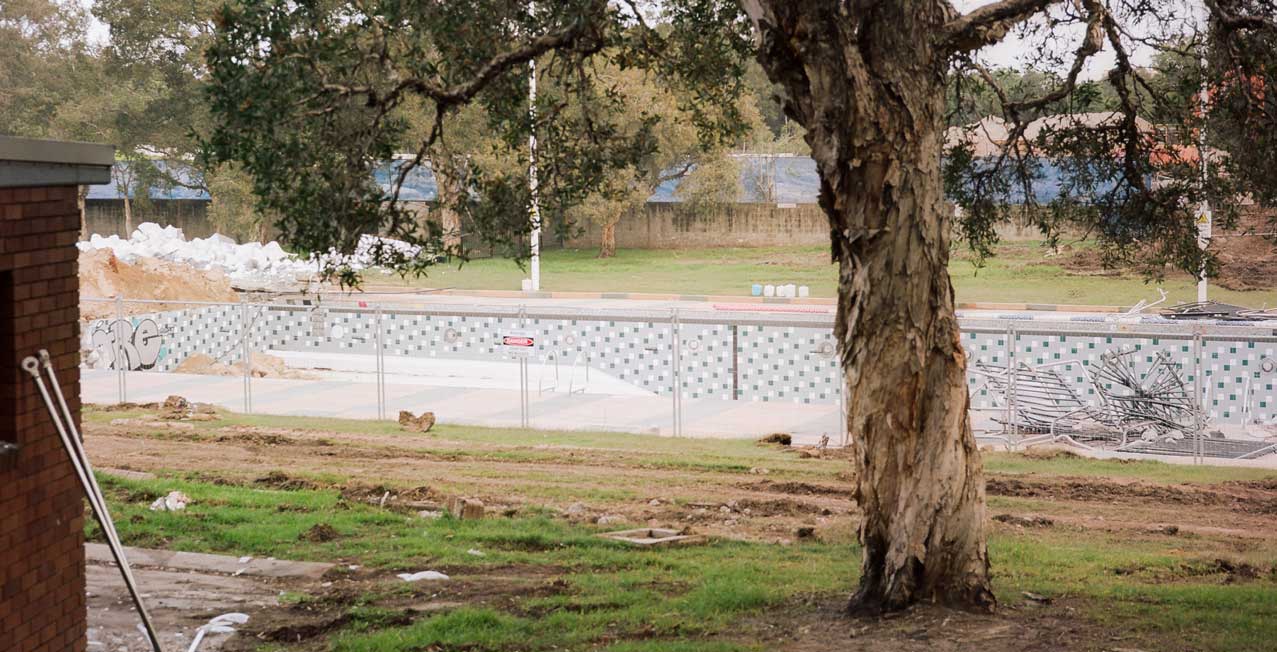
The remains of the Parramatta War Memorial Pool. Image: Chris Loutfy.
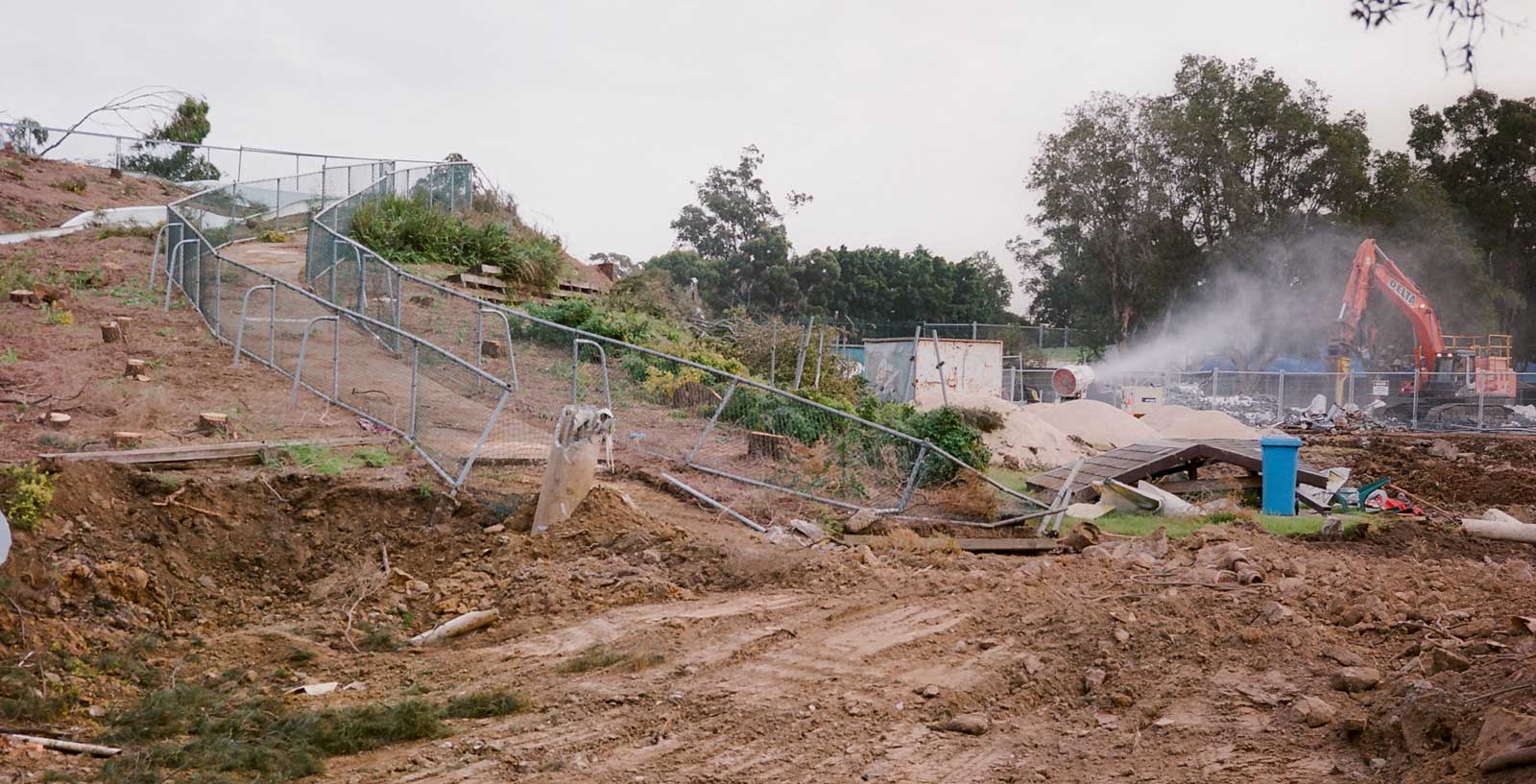
The remains of the Parramatta War Memorial Pool entrance. Image: Chris Loutfy
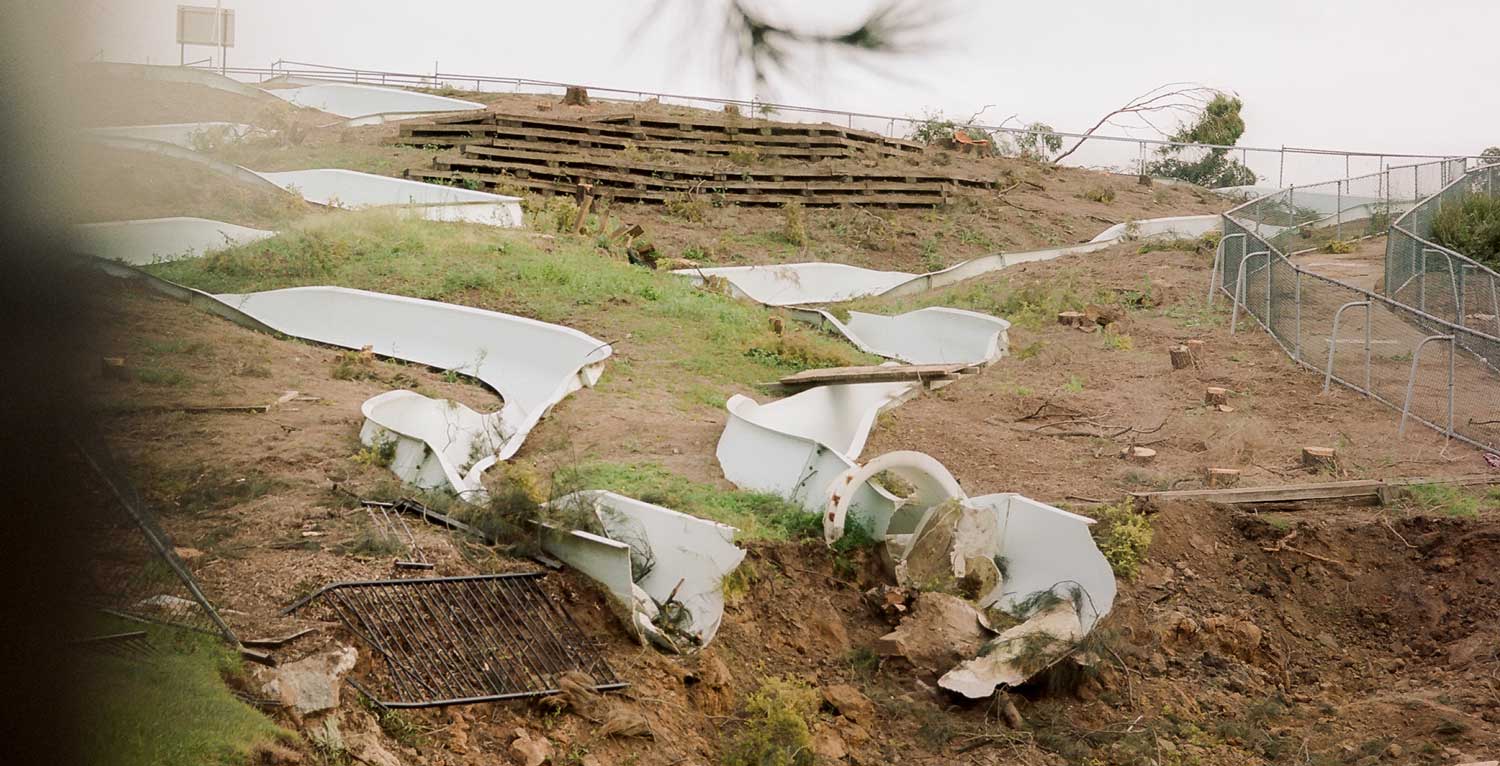
The remains of the Parramatta War Memorial Pool waterslide. Image: Chris Loutfy
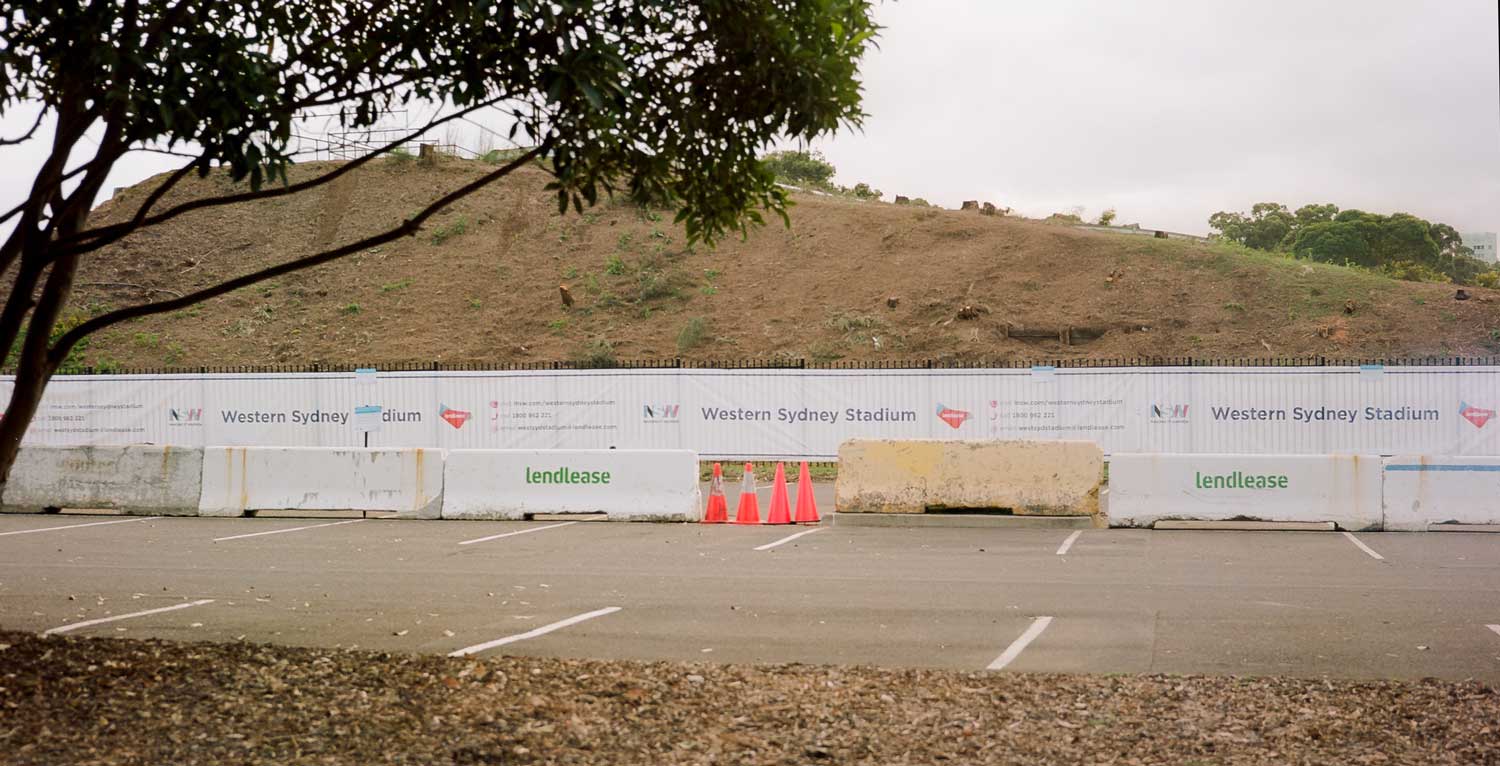
"Making it happen?" Hoarding around the new Western Sydney Stadium. Image: Chris Loutfy
One of the core issues with Parramatta’s transformation is that development appears to be placing state interests above local interests. The $300-million Western Sydney Stadium development will demolish the existing Pirtek Stadium to replace it with a new 30,000 seat facility and a new 500-bay carpark. The Western Sydney Stadium is part of a larger Infrastructure NSW initiative to update sporting infrastructure across the state. Demolition works began in late 2016 with the new stadium set to open in 2019. Some locals raised concerns over whether a 30,000 seat stadium would be big enough for future growth, the increased traffic and car parking issues that the new stadium would generate, and questioned why the nearby Homebush Stadium, which currently has 83,000 seats, was not appropriate for renovation.
The state’s influence is clear when you consider they’re demolishing the Parramatta War Memorial Pool to make way for one of many stadium thoroughfares. A replacement aquatic centre is still in the planning stages, meaning Parramatta will be without a local Olympic-sized pool for years. Because of this, the City of Parramatta Council has to find alternative venues for the 1400 students enrolled in learn to swim programs, with the pool closed since the end of March. The NSW government has committed $30 million towards the new aquatic centre with two potential sites in the Parramatta Park Mays Hill Precinct under consideration, raising the spectre of a further loss of public green space within the park, in addition to that subsumed by the new, larger stadium. The Parramatta Park Trust is currently undertaking a master planning process for the Mays Hill Precinct.
Just up the road from the new stadium is the Parramatta RSL Club, which directly adjoins Parramatta Park. The RSL club was originally allowed to build on its corner site within the park 50 years ago because of its status as a war memorial. Now, the building will be knocked down to make way for a hospitality venue with an open-air function room and proposed underground carpark accommodating 500-plus vehicles, while the RSL plans to sell its existing carpark building outside the park on Macquarie Street for redevelopment.
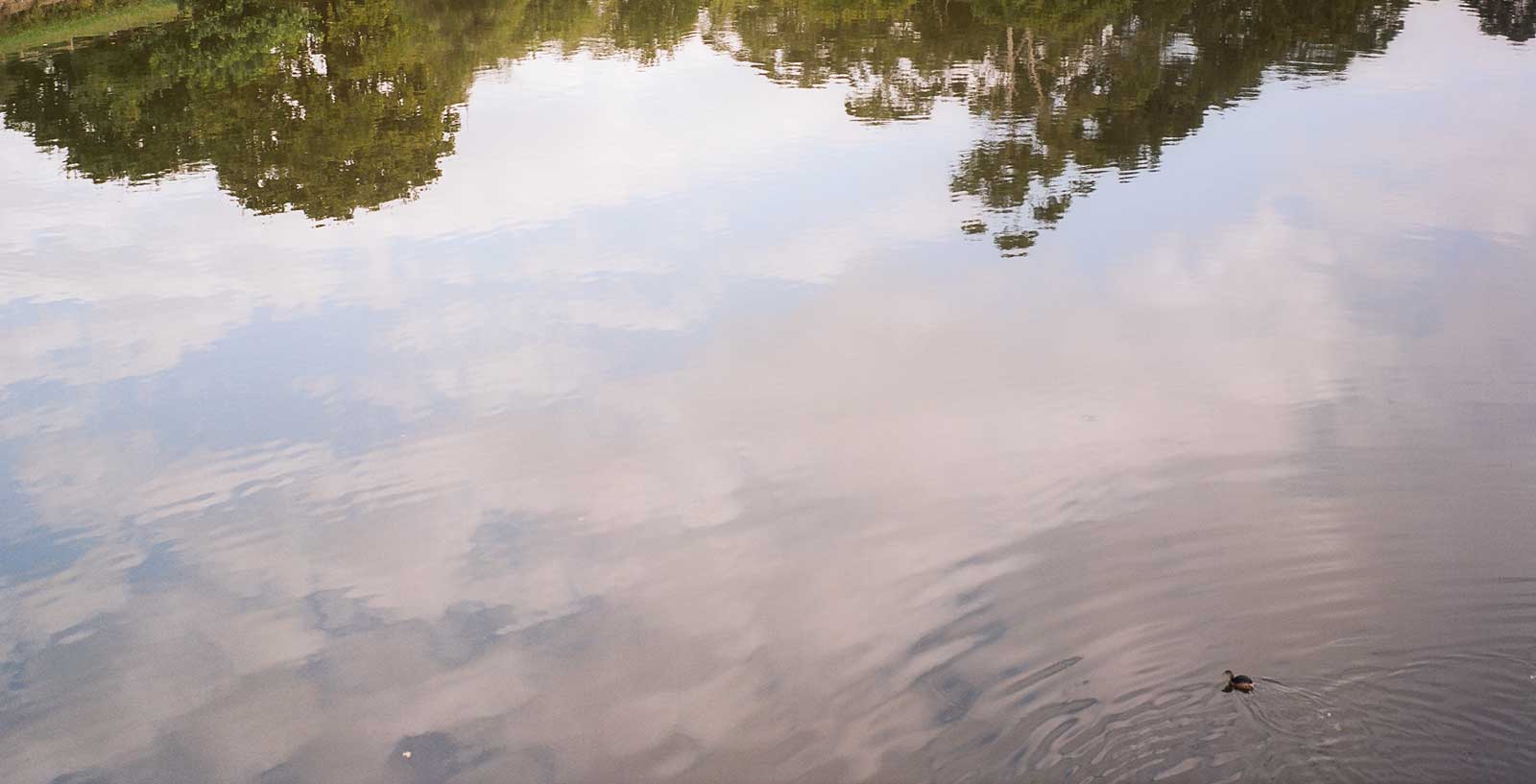
A lesser-known Parramatta Park resident, the friendly park duck. Image: Chris Loutfy
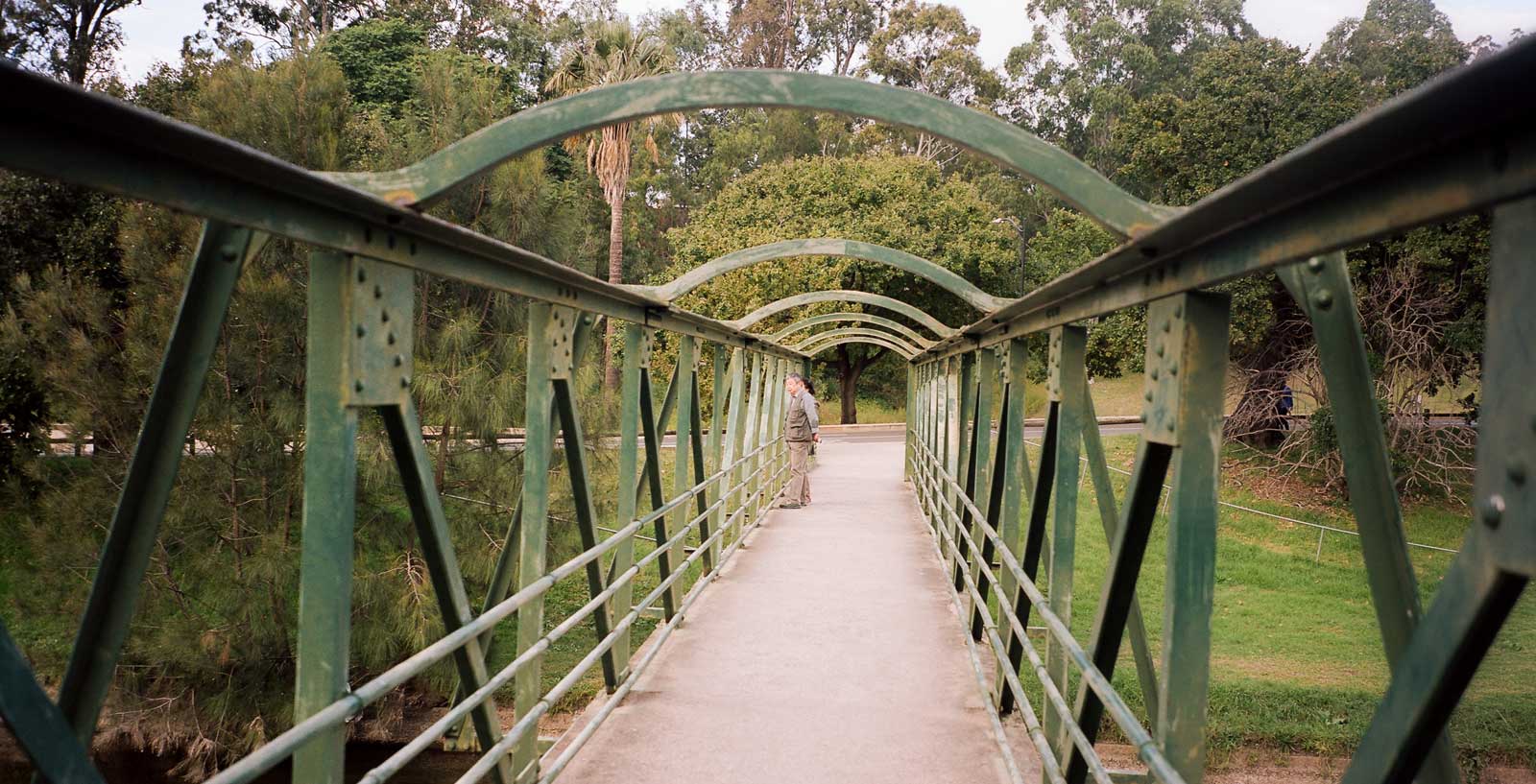
Buttons Bridge crossing the Parramatta River, built in 1931. Image: Chris Loutfy
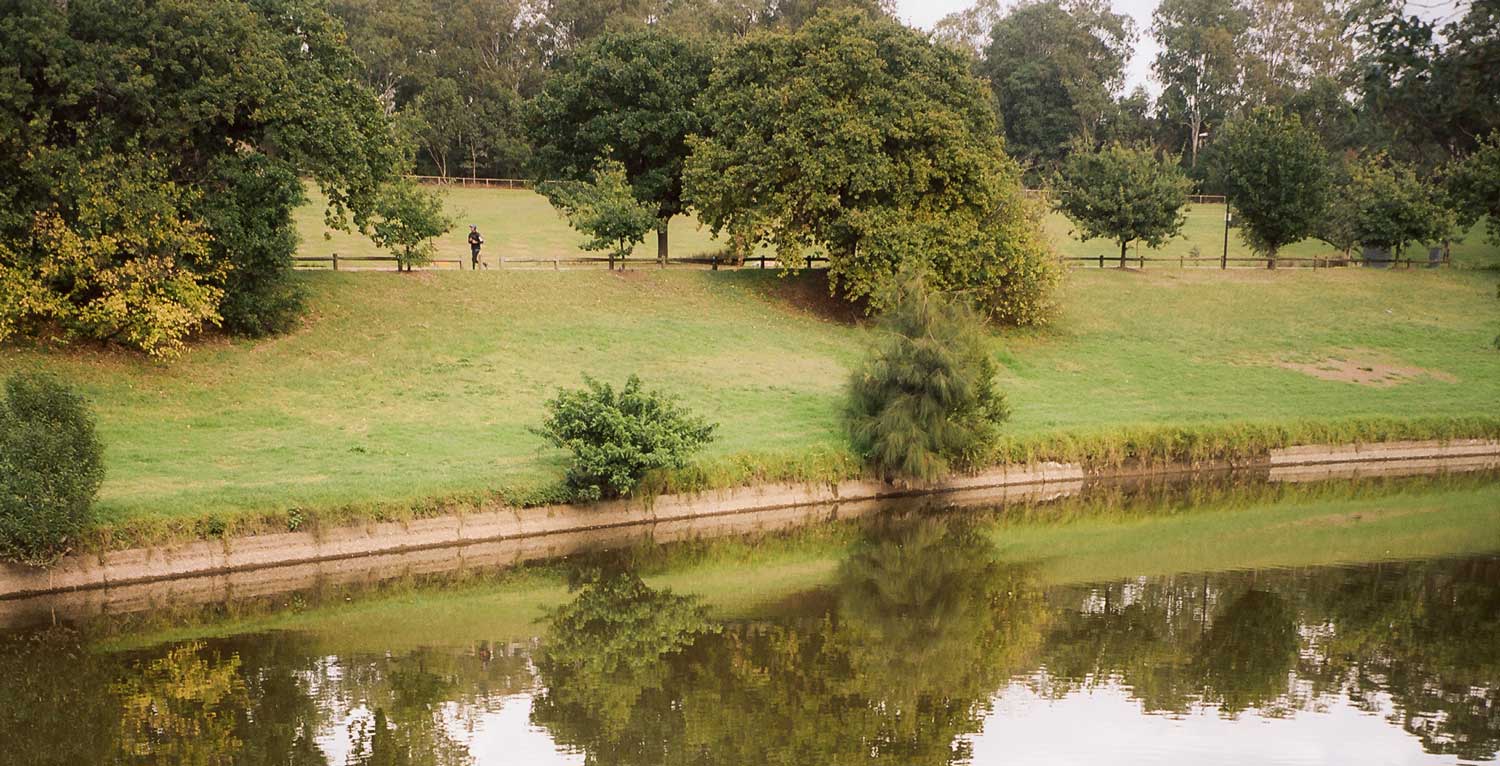
Surrounding parkland around the river. Image: Chris Loutfy
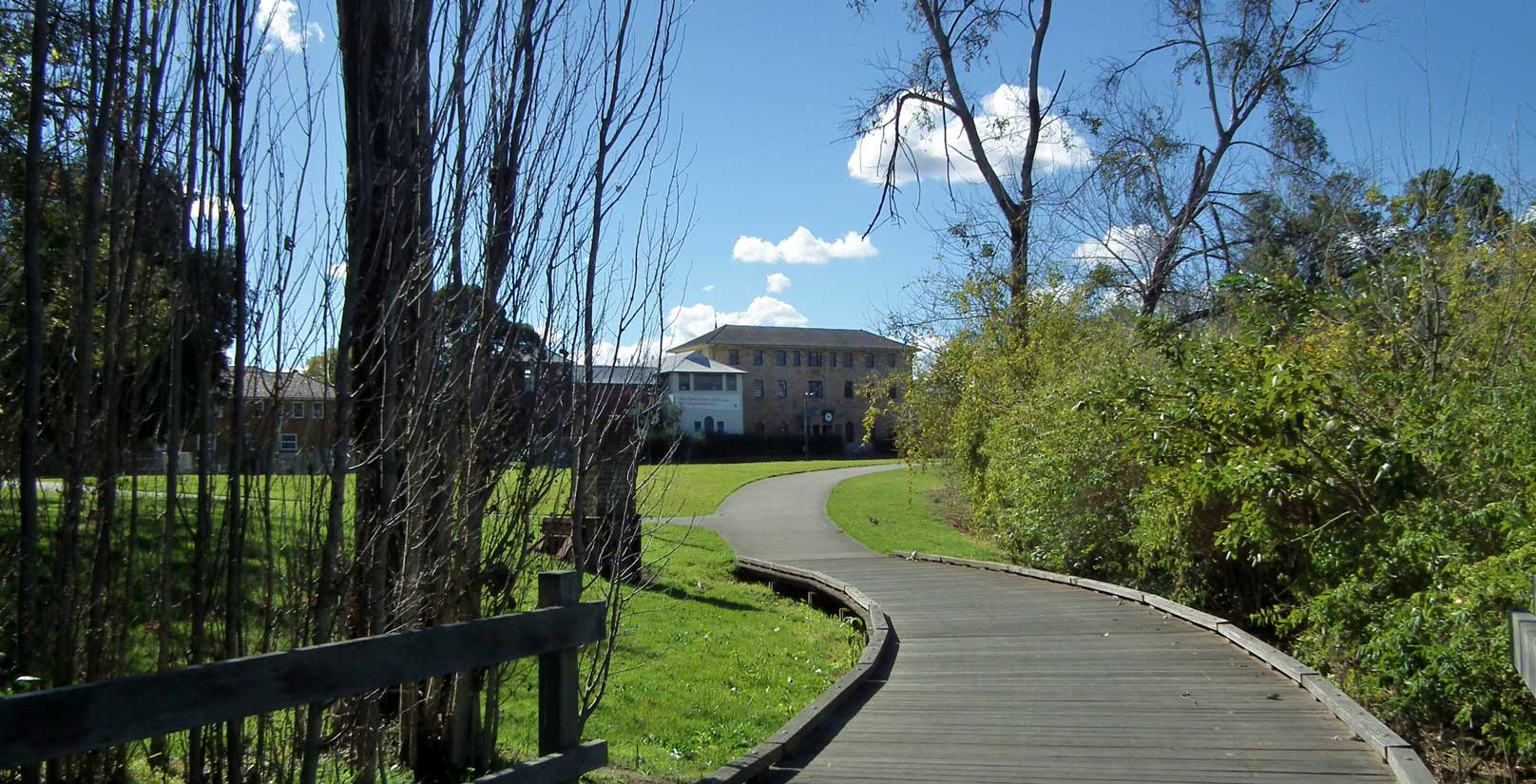
Old Kings School, Parramatta.
Across the river, the old King’s School was initially earmarked as the site of a new arts and culture precinct in Parramatta, with former NSW Premier Kristina Keneally confirming $24.6 million in funding in 2011. The plans were the culmination of years of local lobbying with the City of Parramatta Council keen to see the area developed into a creative arts hub. Yet plans changed in 2015 when the newly-elected NSW government overrode the past decision, to propose a new primary school for the site.
There has been further local controversy around the decision of Parramatta Park Trust to award the lease of the Mays Hill Gatehouse to consultancy firm Think Planners, over a submission for a Western Sydney Creative Centre, made by a consortium of arts and culture professionals to use the building as an office and meeting space. The disgruntled artists complain that the decision is at odds with the objectives of the Parramatta Park Trust’s mandate under the Parramatta Park Trust Act 2001: “to encourage the use and enjoyment of the trust lands by the public by promoting the recreational, historical, scientific, educational and cultural heritage value of those lands”. The decision also appears to be at odds with the cultural discussion paper for Parramatta’s CBD, where it recommends providing “support for professional artists” and “more spaces for our community to create” to ensure Parramatta “is activated with artistic activity, cultural expression, imaginative endeavour and daring ambition”.
Then there is the $18-million Parramatta North Urban Transformation Program being led by UrbanGrowth NSW, which plans to sell off and subdivide 30 hectares of public land for a mix of residential, retail, commercial, recreation and community uses. The land involved sits in close proximity to Parramatta Park and includes grounds and buildings of significant heritage value: Cumberland Hospital (East Campus) and the former Norma Parker Periodic Detention Centre, the Parramatta Female Factory, Lunatic Asylum and the Roman Catholic Orphan School. UrbanGrowth NSW says the program will build 2700 dwellings, restore and adaptively reuse historic buildings, in addition to protecting the habitat of the grey-headed flying fox colony.
UrbanGrowth NSW has undertaken public consultation since planning on the Parramatta North Urban Transformation Program began in November 2013, holding workshops, information sessions and public forums on future uses of the historic precinct. They have also initiated archaeological investigations and repairs to six of the historic buildings. Yet residents, including supporters of the Parramatta Female Factory Precinct Memory Project, are still concerned about some aspects of the program, including the plan to demolish the Taldree and Kamballa buildings that were associated with the Parramatta Girls Home. Concerns linger over developments in the Parramatta Female Factory precinct, which could impact on any future nomination for World Heritage status (although for this to happen, the precinct needs to first be listed on Australia’s National Heritage List, which it currently isn’t).
Parramatta North Urban Transformation aerial footage from UrbanGrowth NSW.
While many of those who support heritage protection for these areas are stridently anti-development, not all heritage supporters are against change and many recognise the economic imperatives that drive development. Unfortunately, historic heritage management has traditionally focussed on protecting isolated buildings or monuments, focussing on the detail of architectural style and “the look” of buildings and their surrounds. This “aesthetic” heritage management approach is ingrained throughout much of our heritage management systems, including at the international level, where the decision by the World Heritage Committee to list the Australian Convict Sites (including Old Government House and Domain) came with the recommendation that Australia needed to: “Pay attention to managing the landscape values of the sites in or close to urban areas by studying the visual impact of their current environment and any projects liable to affect those values”.
The Australian Government with the NSW Government and the City of Parramatta Council have prepared the Conservation Agreement for the protection and conservation of the World and National Heritage values of the Australian Convict Sites, Old Government House and Domain, Parramatta to try and mitigate any negative impacts of high-rise buildings on Old Government House and Domain. The conservation agreement sets controls for the area, including in relation to heights, identifying important views to and from Old Government House that must be conserved and it defines a number of “Highly Sensitive Areas”.
As a heritage professional, I support efforts to mitigate the potentially negative impacts that some developments can have on the setting of a historic building and I applaud the leadership that the Australian Government has taken in pressing for the conservation agreement. Yet sightlines and views are only a fraction of the mix of values that makes places like Parramatta Park special. For heritage management to retain its relevance as an urban strategy, it needs to adapt to become part of the development equation – rather than operating only on the basis that Old Government House is a bounded site that needs to be shielded from the growing world around it. We need an overarching understanding of how Parramatta Park’s historic, indigenous, natural and contemporary values contribute to Parramatta’s identity. All of these values need to be translated into guidelines feeding into the planning system. If the park’s contribution to Parramatta’s identity is not well understood, then these values will continue to be compromised by incremental loss.
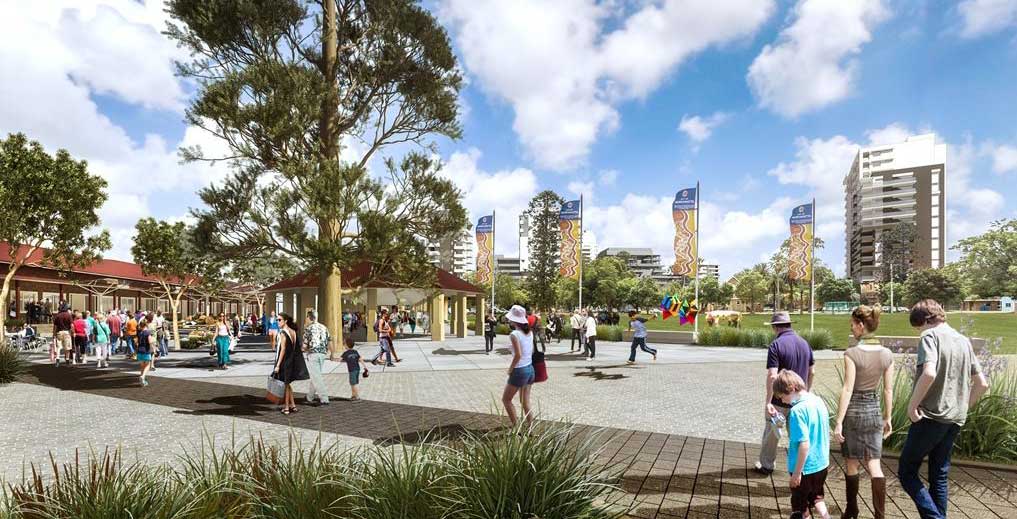
An artist's impression of the redeveloped North Parramatta heritage site. Image: Urban Growth NSW.
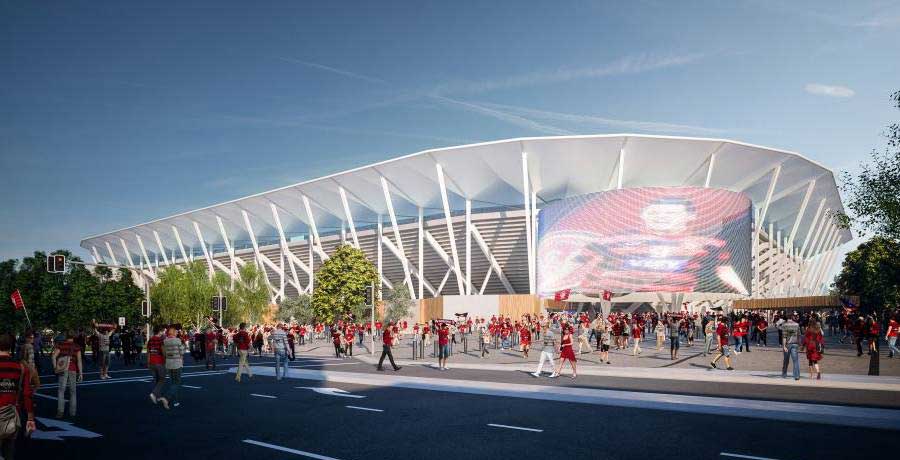
A render of the proposed Western Sydney Stadium. Image: Urban Growth NSW.
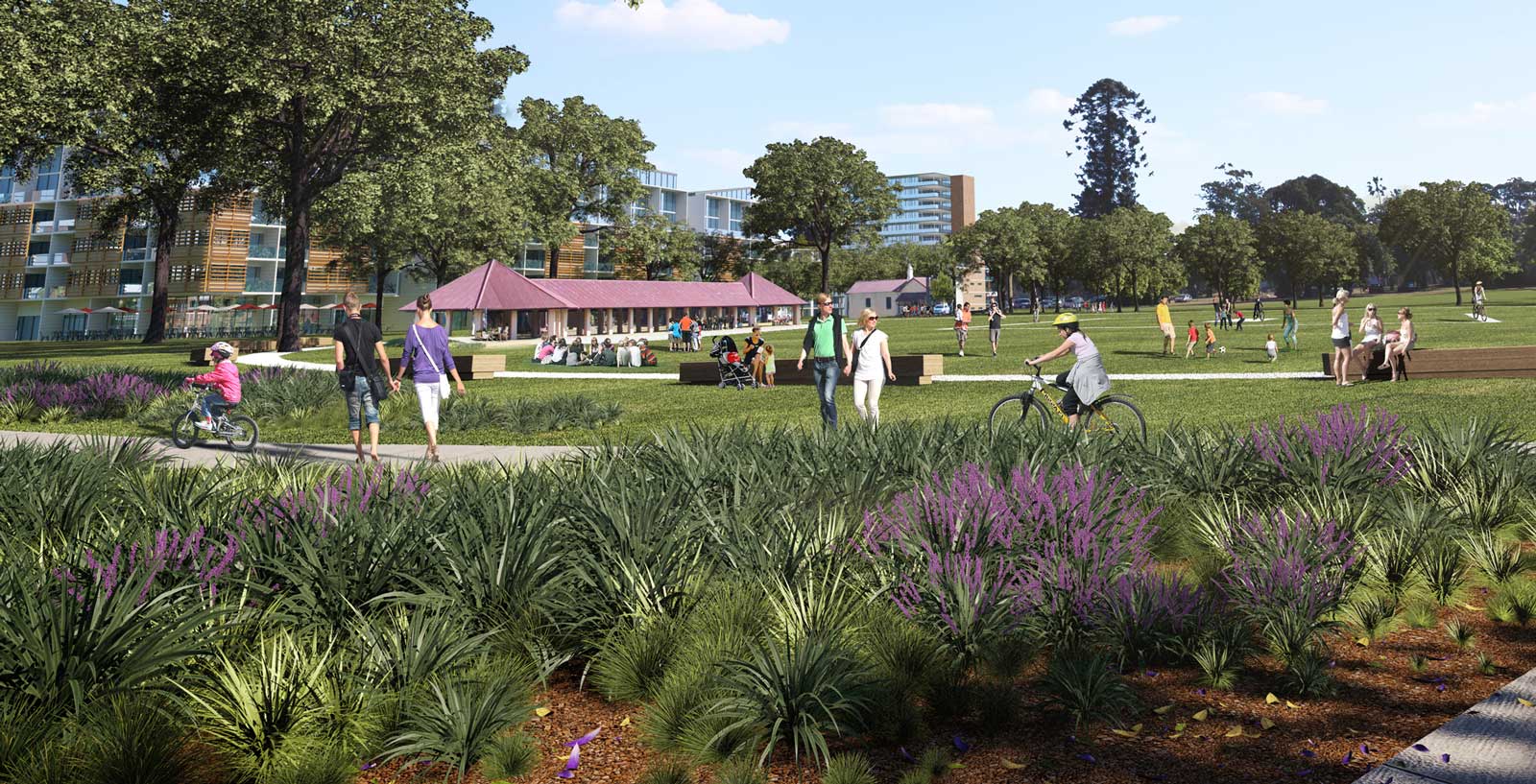
A proposed green area within the North Parramatta Heritage precinct. Image: Urban Growth NSW.
The historic urban landscapes (HUL) approach, a relatively new method for dealing with urban change, promotes elevating the cultural contexts of cities to ensure that planning decisions (especially those taking into account new developments) work to ensure a locale’s sense of place is not lost in the process. HUL grew out of the need to address the tensions between the dynamism of cities and the preservation of historic buildings and civic identity. It has a wider mandate than traditional heritage management, encouraging fields such as planning, economic development and heritage to work more closely together.
The thinking behind HUL is influenced by the work of Scottish town planner Patrick Geddes – an innovator from the early twentieth century who encouraged the links between geography, market economics and anthropology of cities. HUL joins the dots between spaces for work, play and culture, connecting isolated historic buildings with the people that live around them to help create healthier urban ecosystems.
The City of Ballarat in Victoria is part of an international pilot program to implement UNESCO’s Recommendation on the historic urban landscape (HUL). The Ballarat Strategy outlines a plan for managing a projected 60 percent population growth between 2015 and 2040. The strategy was heavily informed by 18 months of consultation with the Ballarat community, which began with what the city council describes as its largest ever community consultation: Ballarat Imagine. The council has found that many heritage systems around the world, including Ballarat’s, have traditionally focused on protecting buildings, monuments or an architectural style. However, communities love their cities for more than their history and aesthetics. Ballarat Imagine told the council that change needed to be carefully managed to safeguard what the community loved most about the city.
The last 30 years have witnessed urban centres growing at unprecedented rates. What then, does the “sustainable city” look like in this context? We can start by asking the right question: what kind of city do we want now and for the future? Defining common interests and understanding what people want out of urban areas are important first steps towards sustainability. The City of Parramatta Council, then, needs to open up a conversation about the values that are associated with Parramatta and it needs to use those values to inform the city’s guiding principles for change. The short of it is that the NSW government is attempting to create a culture for Parramatta without a robust understanding of what its inhabitants value. Growth might be necessary, but there is no reason why it can’t be achieved while protecting and enhancing Parramatta’s unique identity, most especially its green heart.
–
Paulette Wallace has a PhD in cultural heritage from Deakin University and is an active member of the International Committee on Monuments and Sites (ICOMOS) as one of the Australian representatives on the International Scientific Committee on Cultural Landscapes. Paulette’s most recent role was as the executive officer for the Australian Convict Sites World Heritage Property.


